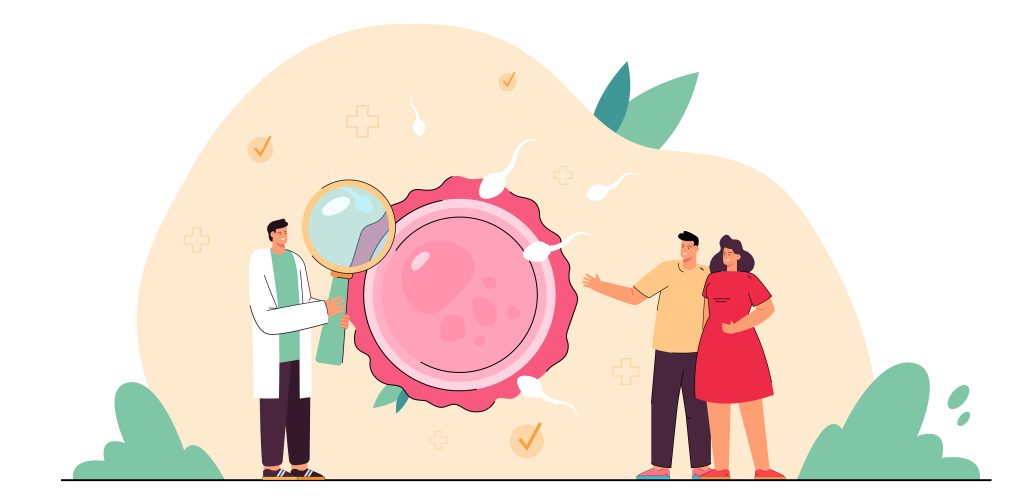Understanding the IVF Process: Step-by-Step Guide
IVF stands for In Vitro Fertilization. In Vitro is a Latin term that simply means “within the glass”. IVF in simple words is a procedure where eggs from a woman’s ovary are combined with men’s sperm in an incubator in a laboratory setting outside the body of a living organism to form embryos. After the embryo culturing, these embryos are later transferred to the woman’s uterus with the intention of establishing a successful pregnancy. It’s a complex and multi- stages procedure used to aid an individual or couples who are struggling with conceiving a child.

The process involves several steps and basically requires the assistance and guidance of a fertility specialist or a reproductive endocrinologist. So, here are the several steps, which are needed to understand the process of IVF:
- Initial Consultation: The first and foremost step of IVF is to schedule a consultation with a fertility specialist. An initial consultation between a doctor and a couple in a pleasant atmosphere is of central importance for further treatment. Who may evaluate your age, and medical history, perform necessary diagnostic tests of both partners and determine if the IVF will be the right option for you or not? They will also further help you to clarify the potential success rates, risks, and costs associated with this procedure.
- Ovarian Stimulation: The second and crucial stage of IVF is Ovarian stimulation. Its main goal is to harvest as many mature eggs as possible from the woman’s ovaries. Harvesting many eggs may maximize the chances of one of the eggs being fertilized. It involves the use of hormonal medications to stimulate the ovaries to produce multiple mature eggs instead of the usual one egg that is released during a natural menstrual cycle. The most commonly used medications are injectable gonadotropins, such as follicle-stimulating hormone (FSH) and luteinizing hormone (LH), which mimic the natural hormones involved in the menstrual cycle. These medications or fertility drugs are prescribed to stimulate the ovaries. Also during ovarian stimulation, regular monitoring is essential to assess the response of the ovaries and adjust medication dosages as per need. Monitoring Sometimes typically involves transvaginal ultrasound scans and blood tests to visualize the growth of ovarian follicles.
- Egg Retrieval: Once the follicles have reached an appropriate size and maturity, a trigger shot of human chorionic gonadotropin (hCG) or a similar hormone is administered. Now here, the trigger shot helps to finalize the maturation of the eggs, preparing them for retrieval. At last, when the eggs are deemed mature, a minor surgical procedure called egg retrieval is performed. After the trigger shot the egg retrieval is typically scheduled for 34 to 36 hours. Egg Retrieval is usually done under sedation or anesthesia. Through the ovaries, a needle is inserted via the vaginal wall, guided by ultrasound imaging, to collect the eggs from the follicles. The eggs are then transferred to the laboratory for further processing.
- Sperm Collection: The Sperm Collection provides the necessary sperm for fertilizing the retrieved eggs. In the laboratory, the collected eggs and sperm are combined in a dish or a specialized culture medium.
- Fertilization: The next step of IVF is Fertilization. Fertilization can occur naturally. The collected and processed sperm is then ready for fertilization, either through conventional IVF, where the sperm and eggs are placed together in a dish for natural fertilization, or through intracytoplasmic sperm injection (ICSI), where a single sperm is directly injected into each mature egg. The specific details of sperm collection may vary based on individual circumstances and the protocols of the fertility clinic. Here the fertility specialist will provide guidance to the patient or couple through the process and suggest necessary instructions and support.
- Embryo Development: The fertilized eggs, now called embryos, is cultured in a laboratory. After fertilization, the embryos are monitored for further development. If any additional embryos are there after the transfer, they will be frozen for future use. This is known as cryopreservation, or embryo freezing. After the period of incubation, the best quality is now selected for transfer. The transfer is mostly done using a thin catheter that is inserted through the cervix and into the uterus. The number of embryos transferred is typically decided based on various factors, including the woman’s age, previous IVF outcomes, and other medical considerations. And also this procedure is usually painless and does not require any anesthesia.
- Luteal Phase: Luteal Phase is the most feasible stage. After the embryos are transferred to the woman’s uterus, the luteal phase begins. This typically occurs in 3 to 6 days after egg retrieval, depending on the specific IVF protocol and the development of the embryos. It can also be called as the period of time following the embryo transfer when the woman’s body prepares for potential implantation and early pregnancy. To support the Luteal phase and enhance the chances of successful implantation, progesterone supplementation is provided. The woman’s hormonal levels and uterine lining may be monitored through blood tests and ultrasound scans, during this phase. Following the embryo transfer, there is typically a waiting period of approximately two weeks before a pregnancy test is performed.
- Pregnancy Test: Approximately two weeks after the embryo transfer, a pregnancy test is scheduled to check out if the procedure was successful or not. This is probably a blood test that more precisely measures the amount of HCG present in the body. If the pregnancy test is positive, it indicates the successful implantation and pregnancy, progesterone supplementation is typically continued for several weeks to support the early stages of pregnancy until the placenta takes over progesterone production. Further monitoring and prenatal care will be provided to ensure the well-being of the pregnancy. But in case, if the pregnancy test is negative, indicating that implantation did not occur, progesterone supplementation is usually stopped, and the menstrual period will begin.
The IVF process can vary slightly depending on individual circumstances and the protocols of the fertility clinic. Your fertility specialist will guide you through all these following processes, they explain each step in detail and provide necessary support and care for you along the way.
Reproductive technology has become tremendously advanced over the past few decades. IVF is also one of the more widely known types of assisted reproductive technology. Its crystal and clear that the IVF process has basically replicates the natural process of reproduction.
Discover the best and most trusted IVF Center in Dwarka Mor, Uttam Nagar for effective infertility treatment. Experience the highest quality care at Sapling IVF. Book your consultation now!

